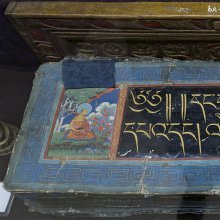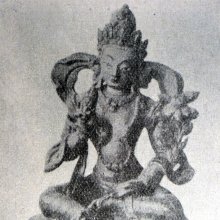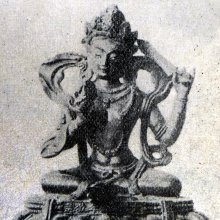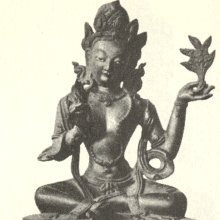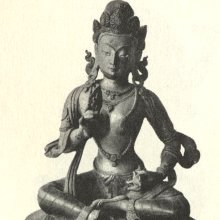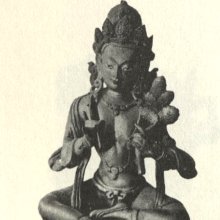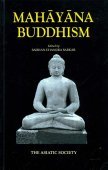Paramita, Pāramitā, Pāramita: 21 definitions
Introduction:
Paramita means something in Buddhism, Pali, Hinduism, Sanskrit, Marathi, Hindi. If you want to know the exact meaning, history, etymology or English translation of this term then check out the descriptions on this page. Add your comment or reference to a book if you want to contribute to this summary article.
Alternative spellings of this word include Permit.
Images (photo gallery)
(+17 more images available)
In Hinduism
Kavya (poetry)
Source: archive.org: Naisadhacarita of SriharsaPāramitā (पारमिता) (in dānapāramitā) refers to “perfection in charity”, and is mentioned in the Naiṣadha-carita 5.11.—[...] Dānapāramitā is a Buddhist term. It is one of the cardinal virtues or Pāramitās of the Buddhists. Cf. Bodhicaryāvatārapañjikā, p. 347. The Kathāsaritsāgara (Taraṅga 72) illustrates six Pāramitās (dāna, śīla, kṣamā, dhairya, dhyāna and prajñā) by means of suitable stories. The Pāramitās are illustrated in a similar fashion in Kṣemendra’s Bṛhatkathāmañjarī 9.1.496ff. Cf. also Mattavilāsaprahasana (T.S.S.).

Kavya (काव्य, kavya) refers to Sanskrit poetry, a popular ancient Indian tradition of literature. There have been many Sanskrit poets over the ages, hailing from ancient India and beyond. This topic includes mahakavya, or ‘epic poetry’ and natya, or ‘dramatic poetry’.
In Buddhism
Theravada (major branch of Buddhism)
Source: Access to Insight: A Glossary of Pali and Buddhist TermsPerfection of the character. A group of ten qualities developed over many lifetimes by a bodhisatta, which appear as a group in the Pali canon only in the Jataka ("Birth Stories"): generosity (dana), virtue (sila), renunciation (nekkhamma), discernment (panna), energy/persistence (viriya), patience/forbearance (khanti), truthfulness (sacca), determination (adhitthana), good will (metta), equanimity (upekkha).Source: Dhamma Dana: Pali English GlossaryF (Noble practice, noble accomplishment). Positive action by means of the body, speech or the mind, which is motivated by a will to progress on the path to perfection, the path of dhamma.
Only when the development of the paramis reaches the peak of its maturity can nibbana be experienced. There are 10 paramis:
- dana parami: Forsaking ones goods and possessions (animals or non living objects) by making gifts.
- sila parami: Control of ones actions and speeches in order to refrain from evil actions.
- nekkhamma parami: Renouncement of the life of the laity to the sake of a solitary life (bhikkhu, ermite).
- panna parami: Development of knowledge and understanding through study and analytical reflection. Imparting knowledge to others. Making use of ones wisdom so as to take the highest benefits from it.
- viriya parami: Effort to do good to others as much as possible and to the peril ones life.
- khanti parami: Establishment of an always perfect tolerance, whatever, on others behalf, performed actions and uttered speeches might be.
- sacca parami: Truthfulness (to tell only what is fair).
- adhitthana parami: Decision to solely perform beneficial actions and to stick to them.
- metta parami: Cultivation of a state of mind turned towards others happiness, to practice love towards all beings.
- upekkha parami: Rejection of hatred and adoration. Not to stick to an idea in particular. Keeping ones mind even minded.
Theravāda is a major branch of Buddhism having the the Pali canon (tipitaka) as their canonical literature, which includes the vinaya-pitaka (monastic rules), the sutta-pitaka (Buddhist sermons) and the abhidhamma-pitaka (philosophy and psychology).
Tibetan Buddhism (Vajrayana or tantric Buddhism)
Source: archive.org: The Indian Buddhist IconographyPāramitā (पारमिता) refers to “perfections”.—These are certain cardinal human virtues carried to perfection in one birth. It is said that Lord Buddha in each of his previous births practised one or another of the virtues and carried it to perfection, and because of that he obtained enlightenment in his last birth. These pāramitās are usually ten in number, but the Vajrayānists raised the number to twelve. In Vajrayāna the craze for deificatian led to the conception of the Twelve Pāramitā goddesses in human form, for the purpose of worship. [...] In the dharmadhātuvāgīśvara-maṇḍala of the Niṣpannayogāvalī an account of the iconography of the Twelve Pāramitā deities is given. Such a description of all the Pāramitā goddesses cannot be met with in any other published literature on Buddhism. The twelve deities collectively have their spiritual father in Ratnasambhava.

Tibetan Buddhism includes schools such as Nyingma, Kadampa, Kagyu and Gelug. Their primary canon of literature is divided in two broad categories: The Kangyur, which consists of Buddha’s words, and the Tengyur, which includes commentaries from various sources. Esotericism and tantra techniques (vajrayāna) are collected indepently.
Mahayana (major branch of Buddhism)
Source: academia.edu: A Study and Translation of the GaganagañjaparipṛcchāPāramitā (पारमिता) refers to “(the aspects of) perfection”, according to the Gaganagañjaparipṛcchā: the eighth chapter of the Mahāsaṃnipāta (a collection of Mahāyāna Buddhist Sūtras).—Accordingly, “Son of good family, these are eight pure vigours of bodhisatvas. What are the eight? To wit, (1) vigour to adorn his body but the body is not the objective support since it is distinguished as a reflection; (2) vigour to accomplish proper speech although the speech cannot be perceived since it is distinguished as voidness; (3) vigour to put the thought into the state of concentration although the thought is not the objective support since it is imagined by the true state of thought; (4) vigour to attain all aspects of perfection (pāramitā) although they cannot be perceived since they are imagined by the true nature of dharma (dharmatā) which is the extinction of the continuous succession of thought (cittaparaṃparā); [...]”.

Mahayana (महायान, mahāyāna) is a major branch of Buddhism focusing on the path of a Bodhisattva (spiritual aspirants/ enlightened beings). Extant literature is vast and primarely composed in the Sanskrit language. There are many sūtras of which some of the earliest are the various Prajñāpāramitā sūtras.
General definition (in Buddhism)
Source: Wisdom Library: BuddhismParamita:—These are practices performed by Bodhisattvas, they are usually listed as the six paramitas, but often the list is expanded to ten. They are: charity, keeping the precepts, forbearance, diligence in practice, meditation, wisdom, to be able to teach by the use of expedient means, keeping your vows, knowledge, and the development of spiritual power.
Source: Buddhist Door: GlossaryThe Six Paramita or means of so doings are:—
- dana - charity/giving;
- sila - moral/conduct/taking precepts;
- ksanti - patience;
- virya - vigor/devotion/energy;
- dhyana - contemplation/meditation;
- prajna - wisdom.
The Ten Paramita are the above plus
- upaya - use of expedient or proper means;
- pranidhana - vow of bodhi and helpfulness;
- bala - strength;
- intelligence.
Childers gives the list of ten as the perfect exercise of * charity/almsgiving, * morality, * renunciation, * wisdom, * energy/effort, * patience, * truth, * resolution/determination, * kindness/universal love and * resignation/equanimity. Each of the ten is divided into ordinary, superior and unlimited perfection, making up to thirty in total.
Source: Shambala Publications: GeneralPāramitā Skt., lit., “that which has reached the other shore,” the transcendental. The pāramitās, generally translated as “the perfections,” are the virtues perfected by a bodhisattva in the course of his or her development.
There are six of these:
- dāna-pāramitā (generosity),
- shīla-pāramitā (discipline),
- kshānti-pāramitā (patience),
- vīrya-pāramitā (energy of exertion),
- dhyāna-pāramitā (meditation),
- prajñā-pāramitā (wisdom).
Frequently four further virtues are added, which were accepted into the canon later:
- upāya-kaushala-pāramitā (right method or means),
- pranidhāna-pāramitā (vow),
- bala-pāramitā (manifestation of the ten powers, dashabala),
- jñāna-pāramitā (knowledge of the true definitions of all dharmas).
pāramitā, (pārami or pāramī [pārami, pāramī, pāramitā]) transcendental virtues or perfections. Pāram means beyond. It means to go, to go to the other shore, that is, to go beyond the realm of saṃsāra. The term pārami is used to denote the virtues to be practised by a Bodhisattva in order to attain the Buddhahood. The following virtues are known as ṣaṭ pāramitā-s, or six virtues. They are explained by the Buddha in the Vajracchedikā Prajñā Pāramitā Sūtra, to Subhūti and the other monks in an assembly.
- charity (dāna),
- morality (śīla),
- forbearance (kṣānti),
- energy (vīrya),
- meditation (dhyāna), and
- wisdom (prajñā).
Languages of India and abroad
Pali-English dictionary
Source: BuddhaSasana: Concise Pali-English Dictionarypāramitā : (f.) completeness; perfection.
Source: Sutta: The Pali Text Society's Pali-English DictionaryPāramitā, (f.) (pāramī+tā)=pāramī Nett 87. (Page 454)

Pali is the language of the Tipiṭaka, which is the sacred canon of Theravāda Buddhism and contains much of the Buddha’s speech. Closeley related to Sanskrit, both languages are used interchangeably between religions.
Marathi-English dictionary
Source: DDSA: The Molesworth Marathi and English Dictionaryparamīta (परमीत).—f n (Corr. from parimiti) Measure, magnitude, determined quantity.
Source: DDSA: The Aryabhusan school dictionary, Marathi-Englishparamīta (परमीत).—f n Measure, magnitude.
Marathi is an Indo-European language having over 70 million native speakers people in (predominantly) Maharashtra India. Marathi, like many other Indo-Aryan languages, evolved from early forms of Prakrit, which itself is a subset of Sanskrit, one of the most ancient languages of the world.
Sanskrit dictionary
Source: DDSA: The practical Sanskrit-English dictionaryPāramita (पारमित).—a.
1) Gone to the opposite bank or side.
2) Crossed, traversed.
3) Transcendent.
-tā 1 Complete attainment, perfection. Ks.-Taraṅga 72.362 illustrates six Pāramitas दान, शील, क्षमा, धैर्य, ध्यान (dāna, śīla, kṣamā, dhairya, dhyāna) and प्रज्ञा (prajñā) by suitable stories; Bṛ. Kath.9.1.496; cf. दानपारमिता (dānapāramitā) 'perfection in charity' दानपारमितयैव वदान्यान् (dānapāramitayaiva vadānyān) N.5.11; नूनमेवं बुद्धेनापि दानपारमिता पूरिता (nūnamevaṃ buddhenāpi dānapāramitā pūritā) (mattavilāsa prahasana).
2) Transcendental virtue.
Source: Cologne Digital Sanskrit Dictionaries: Edgerton Buddhist Hybrid Sanskrit DictionaryPāramitā (पारमिता).—(= Pali id., to prec. plus -tā; in Pali synonym of pāramī or °mi in all respects), (1) = prec., mastcry, supremacy, perfection, in general sense, [compound] with preceding attribute indicating the field of mastery: garbhāvakrānti-°tā Mahāvastu i.214.12 = ii.17.11, supremacy (supremeness, perfection) as regards entry into the womb; sarvakuśaladharma-vaśibhāva-°tāṃ Mahāvastu ii.261.7; jina-°tāve 402.22 (of the Jinas); uttama-damatha-śamatha-°tā-prāpta Mahāvastu iii.64.6 (compare i.237.12 s.v. pārami); sarvacetovaśi-(see vaśin)-parama-°tā-prāpta Lalitavistara 425.22 (prose); in Lalitavistara 376.18 (verse), read probably daśabalaguṇa-pāramita-(m.c. for °tā, which all mss. read; Lefm. em. °mi-)-prāptaṃ; possibly to be classed with (2) below are mahopāyakauśalya- jñāna-(29.10 adds darśana-)-parama-°tā-prāpta Saddharmapuṇḍarīka 29.10; 77.8 (both prose); (2) one or more of a technical list of (usually six, sometimes ten, rarely five or seven) supreme virtues, of Buddhas, or (to be cultivated by) Bodhisattvas; usually rendered perfection; Burnouf, Lotus 544 (App. VII deals with this category) vertu transcendante; the lit. meaning was surely supremacy: (five) Saddharmapuṇḍarīka 334.2 °tāḥ pañca (and pañca is v.l. for ṣaṭ ca Saddharmapuṇḍarīka 142.7); pañcasu °tāsu Saddharmapuṇḍarīka 332.10 (prose), listed in the following as dāna, śīla, kṣānti, vīrya, dhyāna; but a sixth, prajñā-p°, is separately mentioned after the list in 333.1; (six) listed, as just cited from Saddharmapuṇḍarīka 332.10 ff., Dharmasaṃgraha 17 (compare 18 cited below); Mahāvastu iii.226.2 ff.; Divyāvadāna 476.2 ff.; Bodhisattvabhūmi 4.13 ff.; 58.16 f.; Laṅkāvatāra-sūtra 237.6; Asaṅga (Mahāyāna-sūtrālaṃkāra) xvi.2 and 3, commentary; described in brief statements Śikṣāsamuccaya 187.5—15; in Kāraṇḍavvūha 50.16 ff. with substitution of dhairya for vīrya; without listing, but with number 6, Saddharmapuṇḍarīka 17.15; 142.7 (v.l. pañca, above); 256.10; 259.3; 262.1; 264.10; Divyāvadāna 95.19; 265.2; 490.16, [Page342-a+ 71] 18 Avadāna-śataka i.7.4; 16.13; Suvarṇabhāsottamasūtra 37.13; 42.7; Rāṣṭrapālaparipṛcchā 21.7; (seven) the above six plus upayakauśalya-(Lalitavistara mahopā° and adds parama-)-paramitā Saddharmapuṇḍarīka 457.11—12; Lalitavistara 8.2—3; also Lalitavistara 34.20 ff. (with upāyakauśalaṃ); (ten,) the above seven (with upāya for upāyakauśalya in Mahāvyutpatti, Dharmasaṃgraha [upāyaṃ, nom.!], Gaṇḍavyūha) plus praṇidhāna (Dharmasaṃgraha praṇidhi), bala, jñāna, Mahāvyutpatti 913—923; Dharmasaṃgraha 18 (immediately after 17 which lists the six); Bodhisattvabhūmi 371 5 ff.; and in Gaṇḍavyūha 295.10—25 where, curiously, the same list is given but called mahā- vitānadharma, q.v., instead of pāramitā; in Pali, be it noted, the list is (so far as has been recorded) always ten in number, but not quite the same as in [Buddhist Hybrid Sanskrit]: dāna, sīla, nekkhamma, paññā, viriya, khanti, sacca, adhiṭṭhāna, mettā (or metti, Childers), upe(k)khā; in Pali they are called pāramī as well as °mitā; note further a list of ten jñāna-pāramitā-vihāra in Gaṇḍavyūha 537.11 ff., not noted else- where, seemingly a nonce-elaboration of the tenth (jñāna) pāramitā; pāramitā without indication of number, Lalitavistara 274.21 (sarva-°tāsu pāraṃgataḥ); Bhadracarī 19; individual members of the category, dhyāna-p° Saddharmapuṇḍarīka 335.10; dāna-p° Mahāvastu i.102.5; especially frequent is prajñā-p°, q.v., Mahāvastu iii.67.4; Lalitavistara 179.14—15; 427.17; and passim in Śatasāhasrikā-prajñāpāramitā, Aṣṭasāhasrikā-prajñāpāramitā, and other works of this school which makes prajñā-p° its central point; the word is rendered in Tibetan pha rol tu phyin pa, going to the other shore, a fantastic etymological rendering, as if from pāram plus a form of root i; often forms of (pari-) pūrayati, and noun or adj. derivs., are used governing pāramitā, e.g. Saddharmapuṇḍarīka 256.10 (°tānāṃ paripūryai); Kāraṇḍavvūha 50.16 ff. (each °tā paripūrayitavyā)
Source: Cologne Digital Sanskrit Dictionaries: Shabda-Sagara Sanskrit-English DictionaryPāramita (पारमित).—mfn.
(-taḥ-tā-taṃ) 1. Crossed, traversed. 2. Transcendant, (as spiritual knowledge.) E. pāram across, and ita gone.
Source: Cologne Digital Sanskrit Dictionaries: Monier-Williams Sanskrit-English Dictionary1) Pāramita (पारमित):—[=pāra-m-ita] [from pāra] a mfn. gone to the opposite shore
2) [v.s. ...] crossed, traversed
3) [v.s. ...] transcendent (as spiritual knowledge), [Horace H. Wilson]
4) Pāramitā (पारमिता):—[=pāra-m-itā] [from pāram-ita > pāra] f. (for ta-tā?) coming or leading to the opp° sh°, complete attainment, perfection in ([compound])
5) [v.s. ...] transcendental virtue (there are 6 or 10, viz. dānta, śīla, kṣānti, vīrya, dhyāna, prajñā, to which are sometimes added satya, adhiṣṭhāna, maitra, upekṣā), [Monier-Williams’ Buddhism 128] (cf. [Dharmasaṃgraha xvii, xviii]).
6) Pāramita (पारमित):—[=pāram-ita] b pāraya etc. See under 1. pāra.
Source: Cologne Digital Sanskrit Dictionaries: Yates Sanskrit-English DictionaryPāramita (पारमित):—[(taḥ-tā-taṃ) a.] Crossed; transcendent, worth; spiritual.
Source: DDSA: Paia-sadda-mahannavo; a comprehensive Prakrit Hindi dictionary (S)Pāramitā (पारमिता) in the Sanskrit language is related to the Prakrit word: Pāramiyā.
[Sanskrit to German]
Sanskrit, also spelled संस्कृतम् (saṃskṛtam), is an ancient language of India commonly seen as the grandmother of the Indo-European language family (even English!). Closely allied with Prakrit and Pali, Sanskrit is more exhaustive in both grammar and terms and has the most extensive collection of literature in the world, greatly surpassing its sister-languages Greek and Latin.
Hindi dictionary
Source: DDSA: A practical Hindi-English dictionaryParamiṭa (परमिट) [Also spelled permit]:—(nm) a permit.
...
See also (Relevant definitions)
Starts with: Paramitam, Paramitanaya.
Ends with (+11): Ashtasahasrikaprajnaparamita, Balaparamita, Danaparamita, Dashaparamita, Davaparamita, Dhairyaparamita, Dhyanaparamita, Foremost Paramita, Jnanaparamita, Kanakaprajnaparamita, Kshantiparamita, Pitaprajnaparamita, Prajnaparamita, Pranidhanaparamita, Pranidhiparamita, Ratnaparamita, Saptashatikaprajnaparamita, Sarvakushalamulaparamita, Sarvaparamita, Satyaparamita.
Full-text (+89): Prajnaparamita, Danaparamita, Kshantiparamita, Dhyanaparamita, Viryaparamita, Dashaparamitadhara, Paramitam, Shilaparamita, Dana, Ten Paramita, Six Paramita, Dashaparamita, Ten Perfections, Permit, Kavita, Shatparamita, Prajnaparamitasutra, Balaparamita, Six Perfections, Upayaparamita.
Relevant text
Search found 62 books and stories containing Paramita, Pāramitā, Pāramita, Paramīta, Param-ita, Pāram-ita, Pāram-itā, Paramiṭa; (plurals include: Paramitas, Pāramitās, Pāramitas, Paramītas, itas, itās, Paramiṭas). You can also click to the full overview containing English textual excerpts. Below are direct links for the most relevant articles:
Maha Prajnaparamita Sastra (by Gelongma Karma Migme Chödrön)
Part 1 - Definition of mahā in mahāprajñāpāramitā < [Chapter XXX - The Characteristics of Prajñā]
Part 1 - What is the virtue of wisdom (prajñāpāramitā) < [Chapter XXIX - The Virtue of Wisdom]
3. Prajñā of the Buddhas and Bodhisattvas < [Part 2 - Prajñā and the prajñās]
The Indian Buddhist Iconography (by Benoytosh Bhattachacharyya)
Figure 219 - Twelve Pāramitās: Dhyānapāramitā
Figure 220 - Twelve Pāramitās: Praṇidhānapāramitā
Figure 180-183 - Emanations of Ratnasambhava: Vajratārā and Puṣpatārā
Prajnaparamita in Buddhist < [November-December 1931]
Tomorrow, My Birthday < [April 1957]
Tomorrow, My Birthday < [April 1957]
Mahayana Buddhism and Early Advaita Vedanta (Study) (by Asokan N.)
Chapter 2.13 - The Mahayana Madhyamika system
Chapter 4.3 - Reality in Madhyamika (c): The Paramita Discipline
Lankavatara Sutra (by Daisetz Teitaro Suzuki)
Socially Engaged Buddhism (with reference to Australian society) (by Phuong Thi Thu Ngo)
Reciting the Buddha’s name (Pure Land) < [Chapter 2]
Fund Raising For the Poor and Needy < [Chapter 2]
Related products
